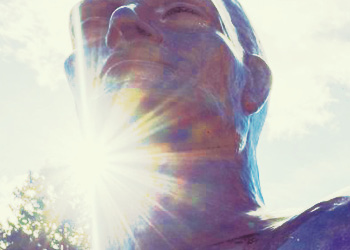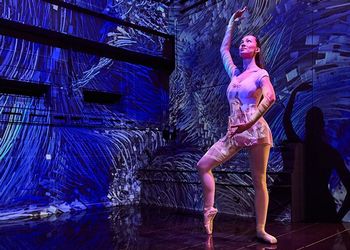Stay Awhile: The MSU Museum

There's a bear in there. For the longest time, he hailed visitors from the lobby. But a few years ago, the sentinel retired from guard duty. Today, he lives just one floor up—in the company of an Arctic fox, a musk ox, an African bongo, a giant anteater and dozens of other animals. They’re just a few of the many wonders waiting to impress sightseers at Michigan State University’s Museum of scienceand culture, in the shadow of Beaumont Tower.
Relocating the bear freed up floor space for more pop-up exhibits. And it cleared the way for docents and curators to greet groups of people for special events and museum tours.
Symbolically, it signaled to visitors “that what they saw here last time is not going to be what they see here this time,” says Lora Helou, the museum’s acting director.
“We don’t want (the museum) to look like a set piece…or some sort of time capsule,” she says with a smile. But at the same time, “we really do try and preserve that balance of longterm exhibits and changing exhibits because we know there are touchstones—like the bear—that some people gravitate to.”
While exhibits come and go, the 159-year-old museum’s mission remains the same, Helou says. “If we can inspire curiosity, a deeper level of learning and a meaningfulness of what these collections represent and how they relate to important issues of our lives, then we’ve done a really good job,” she says.
It’s great to look at cool stuff, but it’s much, much deeper than that. As a destination, the museum is a great place for shared experiences. “We’re as much about our connections as we are about our collections,” she’s fond of saying.
Oftentimes during visits, kids will take the lead and interpret and show their parents and their grandparents what they know. That makes for a vibrant, informal learning environment. That’s a really strong element of what happens here, she says. “The fact that this is multigenerational and accessible to so many audiences makes the museum a very special place.”
The MSU Museum spans three floors with 15 galleries of exhibit space. Displays are driven by four collections: natural science, anthropology, history and culture. Shorter-term exhibits are typically displayed for six to nine months—so there’s always something new to discover.
Drop in if you’re on campus. Be sure to bring your budding collectors, scientists, historians and anthropologists.
Habitat Hall
From Jurassic Times to Today
The skeletons of an Allosaurus and Stegosaurus—cast from bones gleaned from a Utah dinosaur quarry—are big hits with kids. Installed in 1987 and 1988, respectively, the dinosaur exhibit was funded in part by spare change ponied up by schoolchildren.
Hall of Evolution
From Prehistoric Marine Life to Lucy
Fossil aficionados will appreciate this exhibit. Arranged as a timeline, it features evidence of life—from the Cambrian Period, about 540 million years ago, to the Pleistocene Epoch, better known as the Ice Age, some 10,000 years ago. Wall casts invite visitors to feel giant fossil impressions. A diorama of a Michigan Mastodon dig site, maps of shifting landmasses over time and even a full-scale, 3-D likeness of the upright 3.2 million-year-old Ethiopian hominid known as Lucy round out the offerings.
Hall of Animal Diversity
Blending into Nature
This is home to the beloved bear, an Arctic fox, a musk ox, an African bongo and a giant anteater. A cheetah, a serval, a great horned owl and scores of other wildlife share the gallery. They’re real-life examples of how and why animals adapt to survive a host of outdoor environments.
Heritage Hall
Michigan: The Way it Was
Step inside a fur trader’s cabin or a turn-of-the century Crossroads General Store stocked with items from the Rykala Family’s now-defunct general store in East Lake, Michigan. Then peer inside a publishing and printing shop to learn about early life around the state.
Hall of World Cultures
Tour the World through Everyday Objects
Teapots, bells, figurines from Egyptian tombs, drums, masks and Eskimo hunting tools hint at the lives and times of people around the planet.
Life-Size Dioramas
Caribou, moose, elk and other members of the whitetail deer family take center stage in seven colorful dioramas depicting their respective North and Central American habitats. Tundra, boreal forest, an alpine environment, an Eastern deciduous forest, grassland, desert and tropical rainforest colorfully surround these impressive wildlife.
Collections
Vast Collection of Artifacts Demands Care
From a horse-drawn carriage to hat pins, the MSU Museum cares for more than a million items. Artifacts are housed in four separate buildings. “Less than 5 percent of our collections are on view at any one time,” says Lora Helou, the museum’s acting director. “People, a lot of times, are surprised by that. “They really should only be on exhibit for a limited time before we rotate them,” she says.
Every individual artifact is described, studied, catalogued, interpreted and preserved for posterity in climate-controlled conditions. Many are entered into digital databases, making them available to researchers around the world. Some of the museum’s most notable collections include the Michigan Traditional Arts Research Collection, The Great Lakes Quilt Center, mammals and birds, and one of the largest repositories of Great Lakes archaeology collections.
The breadth and depth of its artifacts is a visual feast. In just one storage area are small-scale wooden barns and apparel for men and women, from early American settlers to the Jazz Age and beyond. Primitive surgical tools, Spartan sports uniforms, typewriters, cameras, walls of elaborate masks and Native American weavings comprise just the tip of the iceberg.
Collections are an irreplaceable world resource held in trust for the long-term benefit of society. Natural and cultural history collections are vital for research, education, interpretation, public enjoyment and inspiration, cultural identity, environmental protection and advancement of scientific knowledge, Helou says. “The quilts, for example, are beautiful works of art, representing incredibly skilled traditions passed down from one generation to the next. But more than that, they can tell us about cultural heritage, they can tell us about traditions at risk in a globalized world and the importance of sustaining cultural practices,” she says.
Meanwhile, the natural science specimens can be yardsticks with which to measure habitats and ecology and some of the issues surrounding stewardship of natural resources.
“A challenge for a museum like ours is to truly engage people so that we’re conveying this sense of why we collect and preserve, while explaining how artifacts can connect to peoples lives and the decisions they make.”
For Curious Kids (And Parents)
New Program Targets Youngest Visitors
Schoolchildren, scouting clubs and homeschooled youngsters may visit the MSU Museum in groups. Meanwhile, a new program is geared just for preschoolers accompanied by parents, caretakers and teachers. SEAL–Tots, short for Successfully Engaging All Learners, lends little ones free backpacks full of touchable objects, suggested hands-on activities, stories and games that make the most of their visit.
And a variety of tours are geared for children ages 2 to 5.
Academic Ties
Facility Enhances Student, Faculty Work
With its exhibits, collections and special events, the museum embraces its role in offering academic enrichment opportunities for students. Here are just a few of the ways students and faculty from across campus weave the museum into their curricula.
MSU engineering majors, future physicians, aspiring fashion designers and budding farmers peruse the vast collections for historical perspectives on their fields. Art students sharpen their drawing abilities.
Students in core classes search the museum to answer questions their professors pose. Biology students meet in the museum’s dedicated classroom to examine and learn more about animal specimens.
Students in MSU’s Museum Studies program get hands-on experience at the museum. They help with exhibit planning, research and installing displays.
“The whole building is a learning environment,” says Helou. The museum encourages faculty members to suggest exhibits based on their discoveries. “People can come to see and learn…about Michigan State University research. That sort of stretches us out and intersects with other parts of campus,” Helou says.“That’s part of what a university museum should do,” she says.
Funding
$5.5 Million Fundraising Goal Set
A mix of funding supports the museum. Now through 2018, MSU’s Empower Extraordinary capital campaign supports the museum’s goal to raise $5.5 million. Contributions will enable new and continuing programs, more educational opportunities and fresh exhibits.
Annual memberships, popular public fundraising events, grants from national and state organizations, gifts and donations help to cover operations costs.
Last August, the MSU Federal Credit Union gave $40,000 to the museum in support of child-centric exhibits, programs and activities.
History
Evolution of a Museum: From Curio Collection to Smithsonian Affiliation
Did you save little treasures in a shoebox as a child? Rocks or feathers, maybe? Or perhaps unusual plants and bird nests piqued your curiosity.
You’re not alone. The notion of trying to understand the world through collecting took root during the Age of Exploration, from the 1400s through the 1600s, when European explorers ventured to faraway lands for spices.
Over time, collectors began storing their treasures in what became known as cabinets of curiosities. The contents of some of these cabinets fueled modern museums. In 1857, Joseph R. Williams, president of the Agricultural College of the State of Michigan, now MSU, called for the fledging college to collect “cabinets of natural science specimens…especially of the State of Michigan,” according to museum records.
Faculty member Manley Miles contributed the inaugural objects, acquired during a state natural history survey. Albert J. Cook, one of his students who went on to become a professor here, assembled and oversaw additional collections of geological, entomological and zoological specimens.
By the late 1870s, research areas included archaeology and paleontology, and in 1881 a new library-museum building (now Linton Hall) was constructed to accommodate the expanding collections.
Growing public awareness and interest in natural history encouraged the museum’s acquisitions. As they increased, the museum was moved twice before settling into its current home, a former library building. “There’s a lot of charm and nostalgia with a building like this,” says Helou. “But at the same time, it’s a resourceful reuse of the former library. We’re working progressively to use the space creatively— while introducing technology and finding ways to enhance the visitor experience. “In the last couple of years we’ve really been working to convert some of our linear spaces into gallery-type spaces to make the whole building a learning center,” Helou says.
In addition, the museum produces events and exhibitions off-site—including campus residence halls, the Library, the MSU Union, Cowles House, the MSU Dairy Store, the Veterinary Medicine facility and the MSU Detroit Center. A traveling exhibition service annually provides museum-produced exhibits for nearly 500,000 visitors at libraries, galleries, cultural centers and museums across Michigan, the Midwest and beyond.



